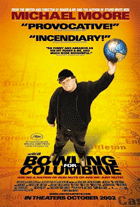 Director: Michael Moore
Director: Michael Moore
Duration: 120 minutes
Year: 2002
Key words: Violence, injury, gun control, conflict
Summary: Michael Moore investigates what he suggests are the causes for the Columbine High School massacre and other acts of violence with guns in the USA.
Degree of public health theme coverage: A documentary on gun violence in America that covers many public health aspects of the gun violence problem. Possible risk factors raised being: ready access to guns; access to semi-automatic weapons; the pro-gun culture; and the culture of fear and violence in the US (with the latter being what is emphasised most). The issue of whether high level violence towards other countries by the US impact on societal attitudes and behaviours at the local/individual level is considered. Eg, US involvement in coups, wars and bombing (eg, in Kosovo at the same time as Columbine). There is also an interview with a spokesperson in an apparent weapons industry factory just near Columbine.
Other public health related issues include: The minimal social welfare and limited access to health care (for the un-insured) in the USA and the stress this puts on families, solo parents. There are also issues of racism in the media towards African Americans and fear-mongering. Score=3/5
Sophistication of analysis of public health content: Overall there is some depth to the themes of gun violence and general violence in the USA. But the comparisons between countries are very superficial eg, although Canada has high gun ownership – there are much tighter controls on hand guns and also gun licensing in general. The Canada vs USA comparison is never properly resolved eg, is it the culture of fear in the USA? Is it the lack of social welfare / safety nets in the USA? The commercialism behind gun and ammunition sales is hinted at – but is poorly developed. There is also a lack of consideration of specific urban issues that may fuel gun violence (eg, poverty and drug epidemics eg, crack cocaine). Score=3/5
Potential for empowerment and use of advocacy: Although the country-comparisons are not that well developed – this still demonstrates a useful advocacy technique.
The director organises a good advocacy stunt that succeeds in getting the chain K-Mart to stop selling ammunition for various guns (this activity involves two boys who were shot at Columbine). Also it shows the capacity for unlimited purchase of ammunition at a K-Mart store.
The head of the National Rifle Association (NRA), Charlton Heston, gives an example of how not to do an interview. From his organisation's perspective it looks likely to have been a mistake agreeing to be interviewed (given Michael Moore's different agenda). Also of note is the successful tactic of Moore in being a card carrying member of the NRA – as this may have helped get access to what this organisation was doing. Score=3/5
Persuasiveness of the movie: Since the movie goes into the issues with some breadth and depth it has some persuasiveness. But the style of the director (he has a strong agenda and quirky style) may mean that this is seen as a rather idiosyncratic documentary. Score=3/5
Engagement and cinematic quality: Reasonably engaging but rather grim but some black comedy moments. The approach seems fairly chaotic at times – and it does not seem to be very well thematically integrated. Overall it didn't seem as well done as his more recent movie “Sicko”. Score=3/5
Total score = 15/25
Questions for discussion:
- What do you think of the argument that state-sanctioned violence is related to violence at the small community level?
- How might gun violence in the USA be reduced based on what is portrayed in this movie?
Other information:
- The DVD has various material including interviews with the Director that may be of some interest to viewers.
- There is a Wikipedia article on this movie - found here (this includes specific criticisms of various aspects of the movie).
- The trailer can be seen on YouTube - found here
- Back to Films in Undergraduate Public Health Teaching home page
CONTACT US
Associate Professor Nick Wilson
Department of Public Health
University of Otago, Wellington
PO Box 7343
Wellington South 6242
New Zealand
Tel: +64 4 385 5541 ext 6469
Fax: +64 4 389 5319
Email: nick.wilson@otago.ac.nz